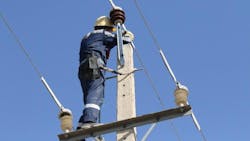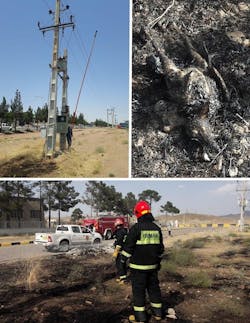Iran's Crowdsourcing and Other Unique Bird Intervention Methods on Power Lines
Electric utilities throughout the United States know that wildlife climbing, perching, and nesting on power lines can create immediate, costly, and sometimes dangerous maintenance issues. What the U.S. utility personnel might not know, is that electric utilities are addressing these issues world-wide.
Although the species and configurations involved in Iran differ from those dealt within the United States, the overall issues of phase-to-phase and phase-to-ground contacts are consistent. The Iranian electric utility industry, which consists of 127,581 km of transmission lines and 815,367 km of distribution lines serving 82 million residents, and where electricity use is growing by approximately 8%/year, is addressing the issues in unique ways.
To address bird concerns, Iran’s Birds and Power Lines Committee (IBPLC) was formed within Iran’s Ministry of Energy to provide advice and instructions to Iranian electric utilities seeking to minimize the occurrence and consequences of negative interactions between wildlife and overhead electrical systems. The IBPLC’s goal is to minimize impacts to the country’s wildlife, but “a rising tide lifts all boats.”
In Iran, as in the United States, minimizing wildlife electrocutions is good for many aspects of the electric utility business, from operations and maintenance to public relations, the bottom line, and fire mitigation. In Iran, the utilities’ responsibility for responding to outages includes not only getting the lights back on as quickly as possible, it also includes financial reimbursement to factories at 100 to 150 times the price of the electricity that is unavailable during outages, and fines scaled inversely to the scarcity of the species involved.
One area where interest in the interactions between power lines and the environment is growing, is the role that wildlife climbing, perching, and nesting on power lines plays in igniting wildfires.
These interactions were first documented by researchers in Spain, then separately by researchers in the United States. The IBPLC has been documenting the phenomenon in Iran. Fires are started when an animal climbing, perching, or nesting on an overhead electric structure is electrocuted, is ignited by the subsequent fireball, and then falls burning into dry vegetation which is ignited in turn. As catastrophic wildfires become increasingly common in the American West, strategies to prevent ignitions become increasingly important. One of the easiest ways to reliably reduce wildfire ignitions is to reduce the risk of wildlife electrocutions.
The Iranian electric utility industry uses a variety of methods to limit wildlife contacts. Similar to the mitigation measures in the U.S., electric utilities in Iran use conductor covers or fiberglass crossarms to prevent wildlife from making simultaneous contact with conductors and grounded crossarms. Regarding these, Mr. Ebrahim Sharifipour, manager of research center at the electric distribution company of Lorestan Province, says, “We have used insulating materials such as silicone rubber covers on grounded parts of our distribution pylons for at least a decade. These are highly recommendable due to minimizing bird electrocutions and unplanned outages.”
As much of the distribution system in Iran (as in much of the world) is composed of steel crossarms mounted on grounded concrete pylons, these solutions alone address a substantial component of wildlife-related issues there. Electric utilities in the United States have long-used wood crossarms and wood poles, which substantially reduce risks to wildlife compared to conductive crossarms and poles, but U.S. utilities also sometimes use steel or concrete distribution structures.
With those structures, phase-to-ground separation becomes substantially less, and becomes much more like the separations on distribution systems throughout much of the rest of the world. To address risk on those structures from wildlife electrocution and animal-caused outage perspectives, electric utilities in the U.S. need to make adjustments that consider the reduced phase-to-ground separation. The IBPLC is also exploring the use of perch deterrents in key locations next to conductors to shift wildlife away from climbing, perching, or nesting in high-risk locations. The U.S. utilities use perch deterrents relatively infrequently compared to the use of covers. However, electric utilities may find that carefully designed and carefully placed perch deterrents, similar to those used in Iran, may help reduce the negative consequences of wildlife contacts on grounded structures in specific situations.
The IBPLC is also working to address wildlife electrocutions on equipment. As in the United States, covering jumpers, installing arrester caps, cutout covers, and bushing covers limits the potential for phase-to-ground or phase-to-phase contacts. This in turn limits wildlife electrocutions, and the myriad negative consequences resulting from those electrocutions.
One particularly unique solution being explored by the IBPLC is the installation of nest boxes on distribution structures so that cavity nesting species can be used to fend off stick nesting species who build their nests across conductors. “Nest box installation can increase our lines’ reliability by reducing the number of natural nests on hazardous parts of the line, particularly transformers,” reports M. Ali Akbar Basiri, research center manager, at the electric distribution company of Markazi Province in Iran.
In a description of work with nest boxes published last year in the Journal of Raptor Research, IBPLC described how installing nest boxes resulted in increased nesting by Eurasian Kestrels, reduced nesting by corvids (birds in the crow and raven family), reduced outages, and reduced bird electrocutions. In that project, the IBPLC could attribute outages to specific nests because the IBPLC cleverly deployed fault indicators spaced regularly along the power line where nest boxes were installed. In doing so, they quantitatively documented the role of stick nests in causing outages, and the role of nest boxes in reducing outages.
This approach also provides a more environmentally friendly option to addressing nesting issues than other methods. Says, Mr. Saeed Zarneshan, director of the HSE (health, safety & environment) department at the Khorasan Regional Electricity Company, “Concerning the breeding birds on our transmission pylons, we believe in nest management rather than nest destruction,” as we work toward creating an overhead electric system that fits safely within the natural world.
Another unique solution being explored by IBPLC is the use of crowd-sourced data describing wildlife incidents involving power lines. In that approach, IBPLC members are part of multiple social media groups wherein electric utility linemen post observations from the field. These social media groups facilitate peer-to-peer learning as linemen post and respond to one another on day-to-day operations and maintenance issues, including wildlife electrocutions and nesting. In the United States, linemen posting images such as electrocuted wildlife or fire ignition points attributable to electrocuted wildlife is disallowed by most utilities, but the Iranian use of social media does demonstrate the potential for widespread learning and improvement in a context where those posting restrictions do not exist.
Overall, the Iranian electric utility industry and the U.S. electric utility industry have far more in common than many may realize, and each can benefit from the knowledge of the other. This is particularly true with respect to conductive distribution structures, with energized equipment such as arresters, cutouts, and transformers, and as the western U.S. becomes increasingly influenced by drought and fire ignition risk. We are creating overhead electric systems and living landscapes more similar to those of Mediterranean Spain and Iran than we might realize.
About the Author
James F. Dwyer
James F. Dwyer, PhD, is a certified UAS pilot, certified wildlife biologist, and research scientist at EDM International, Inc. He works with electric utilities throughout North America and Europe to develop decision-relevant UAS operations and wildlife conservation research. He volunteers time for the Raptor Research Foundation as an associate editor, Conservation Committee Chair, and Code of Conduct Committee founding chair. Dwyer focuses on addressing wildlife conservation and management needs for the industry.
Mahmood Kolnegari
Mahmood Kolnegari is the founder of Iran’s Birds and Power Lines Committee, and holds a Master’s degree in Entomology from the Islamic Azad University of Arak. His work in support of conservation in the electric industry includes research on the effectiveness of numerous electrocution and collision mitigation techniques, and translating international studies from English to Persian to make them accessible to his colleagues. Mr. Kolnegari’s efforts have been recognized with a National Animal Rights Activist of the Year award, and with a National Hero of Wetlands award.




